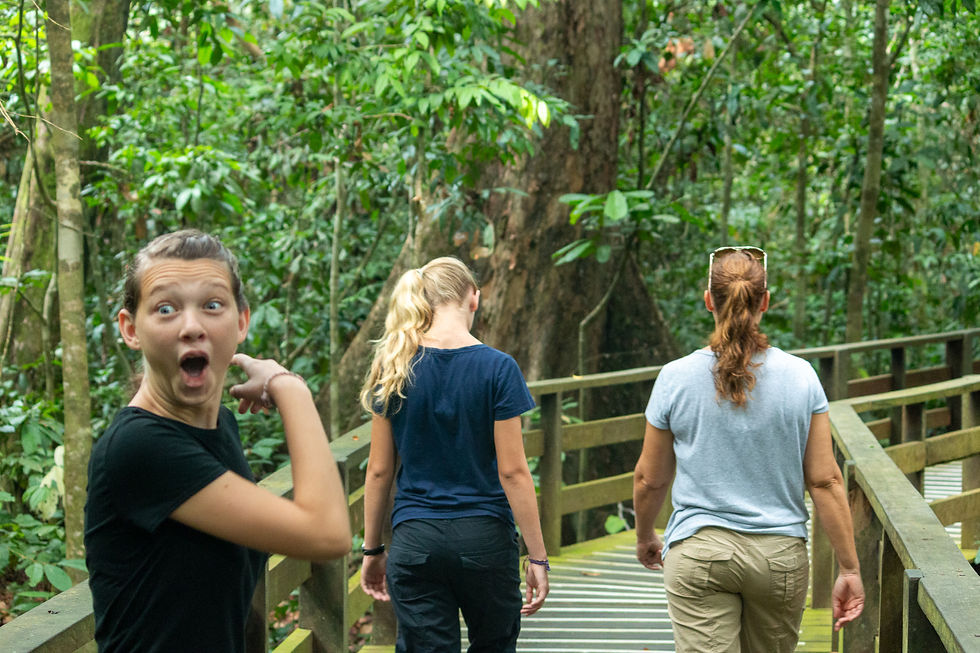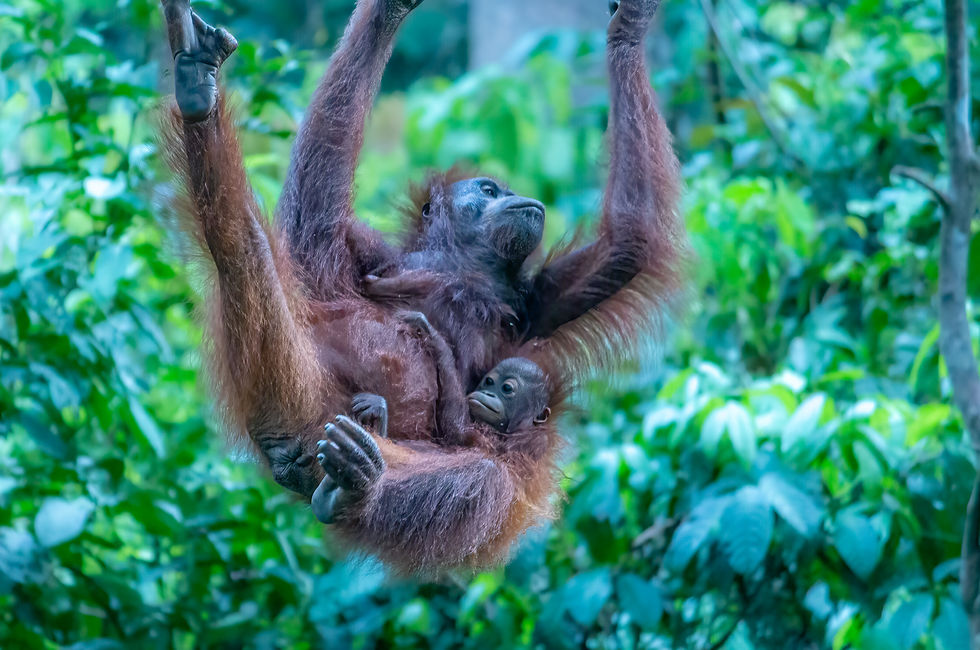Sepilok Orangutan Rehabilitation Center: A Journey to Glee in Borneo
- Rand Blimes

- Apr 28
- 6 min read
Updated: May 6

We had come to Borneo in large part to look for orangutans, the only great ape that lives outside of Africa.
If you take a drive through Borneo, you might be tempted to think your drive is mostly through forest. But if you look closely, you will notice that the trees in the “forest” are aligned in neat rows, stretching on for as far as you can see. Forests don’t grow in rows — agriculture does. Much of Borneo’s old growth forest has been cleared for coconut, or palm plantations. What once was wild jungle is now orderly progress.
And progress is good. But not for all. If there are winners, there are probably also losers. And the Bornean orangutan is clearly a loser in this story. According to the World Wildlife Fund, habitat loss (and poaching) has resulted in a 50% decrease in the number of Bornean orangutans in the last 60 years.
There are relatively few areas of Borneo that offer large tracts of wild forest, but in those areas that do have enough suitable habitat to support an orangutan population, several conservation and preservation organizations have sprung up. One of these organizations is the Sepilok Orangutan Rehabilitation Center. This organization rescues illegally captured or orphaned orangutans and helps them get back to the wild.
In the wild, newborn orangutans stay with their mothers for up to six years, learning the basic skills of survival. When a young orangutan’s mother is killed or captured, he or she will die without help. The Sepilok Orangutan Rehabilitation Center takes in these orphans, teaches them the skills they need to survive on their own, and then releases them back into the forest.
To help with the transition into the wild, the center has two feedings each day. Once in the morning and once in the afternoon, a worker comes to a platform in the forest and provides bananas to any orangutans that decide to show up. The worker only offers bananas, purposefully offering a monotonous diet to encourage the orangutans to forage for some variety. In this way, the orangutans are at a significantly lower risk of starvation but are learning to fend for themselves.
Visiting the Sepilok Orangutan Rehabilitation Center
When we visited Sepilok, we stayed at a place called Uncle Tan’s B&B (we also stayed at their jungle camp on the Kinabatangan River). Getting there was easy (we just took a taxi from the airport). Once there — or anywhere in Sepilok, for that matter — it is a simple task to get to the Orangutan Rehabilitation Center. Uncle Tan’s had a free van that made two trips per day. It is also a fairly straightforward walk from most of the hotels in Sepilok. Guesthouses are all set up to help the traveler get to the center.
We decided to give ourselves enough time to see both the morning and the afternoon feedings. The morning feeding occurs at 10:00 a.m., so we caught the first van from Uncle Tan’s to the center at about 9:00.
It costs 30RM (about $7US) for a ticket that will get you into both daily feedings. You purchase your ticket and then are required to leave your baggage at a locker near the entrance. You then simply follow the wooden walkway through the forest to the feeding area. It is impossible to get lost if you keep to the path.
We walked quietly, reverently into the Bornean jungle for the very first time. As we walked, we scanned the trees all around in hopes of catching a glimpse of an orangutan before the feeding. And we weren’t disappointed.
Not five minutes after we entered the forest, I caught a glimpse of movement up in the trees. “Oh my gosh. Oh my gosh. Oh my gosh. Oh my gosh . . .” I repeated over and over as I quickly moved forward to stand right below my very first orangutan.

It toyed with us, coming in and out of sight in the thick canopy. But it didn’t stay long. Soon it moved away, and it was as if it had simply vanished. But that glimpse was all it took. I now have a memory that I will keep for my whole life of seeing an orangutan in the trees!
We were early for the feeding, so we followed signs for the nursery. As we walked, we described the moment when each of us had first realized there was an orangutan above us. We fought over who saw it first. I jumped up and down with glee. Sheer glee! Once you hit the age of “grown up” moments of pure glee can be all too rare. But I had one at the sight of that ape moving through the treetops.
Pure. Glee.
We made it to the nursery, where we were delighted to be able to sit in an air-conditioned area while we watched juvenile orangutans basically enjoying recess. There was a wooden jungle gym, and ropes, and nets, and the orangutans had fun.
But seeing them just wasn’t the same as seeing the one in the trees.

The Morning Feeding Experience
We went back for the first feeding. A group of tourists (now including us) was gathered along a wooden viewing platform. As we stood quietly, a man emerged from the jungle. On his back he carried a basket, and in that basket was a very large bundle of bananas. The man climbed up a ladder to a raised wooden platform set around a large tree and waited.
A thick rope ran from the tree at the feeding platform into the jungle. And suddenly that rope started to move. My eyes traced the path of the rope from the feeding platform to where it disappeared into the foliage. And I waited. Poised for more glee.
Soon, an orangutan appeared, hanging upside down from the rope, moving hand over hand, foot over foot toward the feeding platform. Soon this orangutan was joined by another. For about 30 minutes the two apes ate on the platform.
We watched. There was glee.

Why You Should Stay for the Afternoon Feeding
After the feeding, we walked back to the entrance and watched a short movie about the work the center is doing. We sat in the air-conditioned cafeteria by the entrance, eating ice cream and continuing to argue about who had seen the orangutan in the forest first.
We went back to our hotel for lunch, and to kill some time until the afternoon feeding, which takes place at 3:00 p.m. Once we got back to the hotel, inertia took over and we got lazy. We debated whether we should go back for the afternoon feeding. After all, we had already seen orangutans now. Did we need to brave the heat and humidity to see them again?
In the end, we decided yes, we did need to go see them again. After all, there had been glee!
And it was a good thing we returned, because the afternoon feeding was spectacular.
It started out as the morning feeding had. The same man emerged with his bundle of bananas. An orangutan came out on the same rope. And then another came. And then another came. And then another. And another.
And then a mother WITH A BABY!!!
Then a few more came.
Then another mother WITH ANOTHER BABY!!!!!

And after the bananas were gone and most of the orangutans had left, one orangutan stayed and joined us for a walk in the forest (more on that in my next post).
That afternoon was perhaps the greatest animal experience I had ever had to that point in my life. There was so much glee I didn’t know what to do with it all.
And to think we almost missed the experience so that we could lay in our beds at the hotel watching movies on our tablets.
I am extremely grateful, because travel taught me an important lesson that muggy afternoon in Borneo. If you want glee in your life, you had better get out there and do what you need to do to grab the opportunities that may come around.




Comments